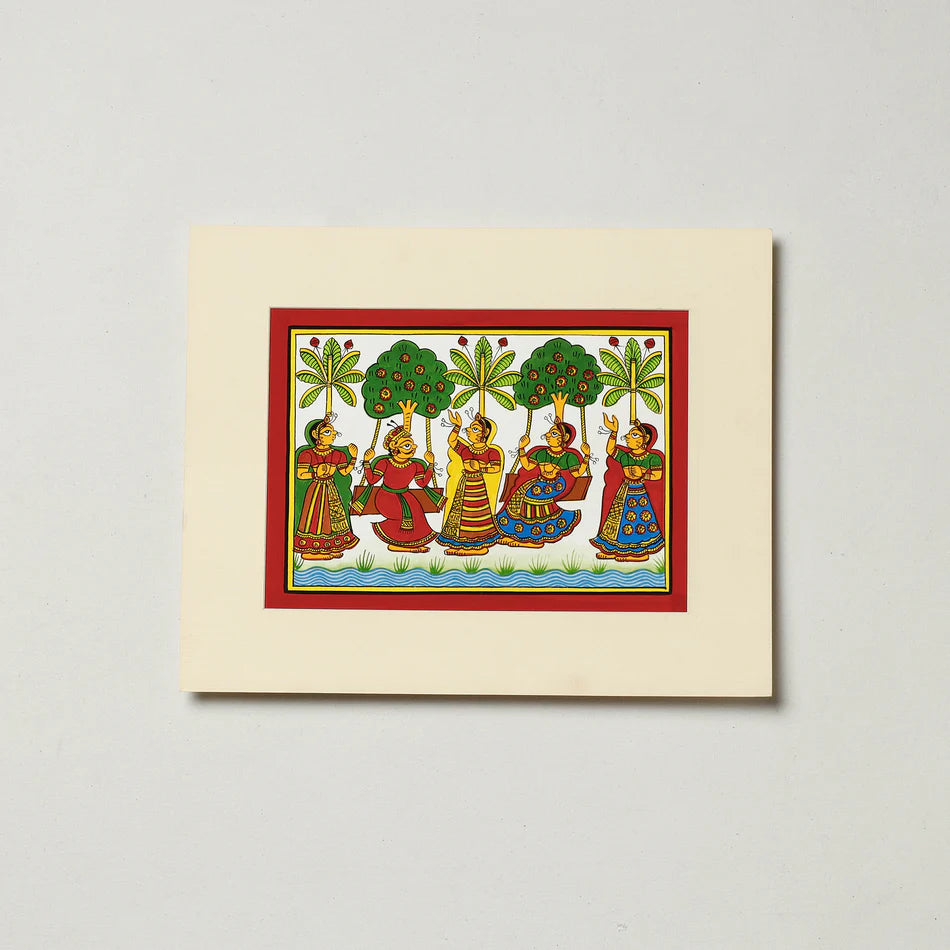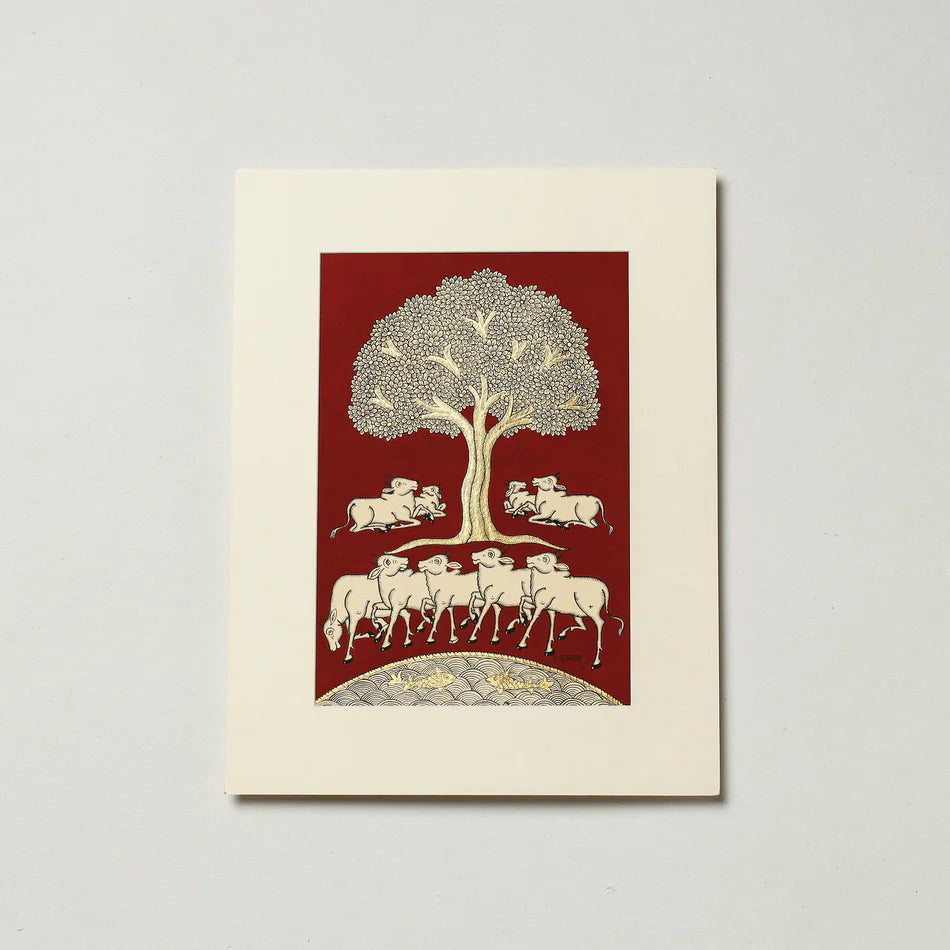Rajasthan, the northwestern state of India boasts of rich arts and traditional crafts. The handicrafts of Rajasthan are matchless in terms of their aesthetics, technicality, and diversity. The state ranks among the top exporters of traditional Indian crafts. Rajasthani folk art has gained popularity worldwide. Phad painting of Rajasthan is one such craft which is known for vibrant colours and is a unique kind of storytelling artwork. This blog will dig into the fascinating world of Phad paintings and explore Phad painting origin and history and also learn about their relevance in safeguarding Rajasthan's cultural legacy.
What is Phad Painting of Rajasthan
Phad painting is a traditional Indian art form from Rajasthan that is renowned for its vivid hues, minute details, and engaging narratives. It is one of the unique Rajasthani traditional paintings which represent religious and mythical tales, frequently highlighting the valiant actions of folk gods.
Phad is 7 century-old style of storytelling artwork done on scrolls and is an important part of Rajasthan’s religious traditions.

Phad Painting Origin & History
The history of Phad painting of Rajasthan spans more than seven centuries. Phad painting history is pretty fascinating as only one family has been practising and popularising it for centuries.
The Joshi family of Shahpura in the Bhilwara area of Rajasthan are considered to be the traditional creators and keepers of this Rajasthani folk art form. The Bhopa society, a group of travelling minstrels, used these Rajasthani traditional paintings primarily as portable fabric scrolls to tell the stories of folk deities.
Phad paintings were initially produced as movable cloth scrolls known as "phads." The "phad kavitas," lyrics or couplets that accompany the phad scrolls, were recited by the Bhopas as they unfolded them to bring the stories to life.
The earliest Phad scrolls were ordered in the 10th century A.D. by Chochu Bhat, a follower of Lord Devnarayana and the clan's chronological master.
Themes & Narratives Used in Phad Paintings
Phad Paintings of Rajasthan are known for their religious and mythological narratives. The lives and valiant actions of folk deities like Pabuji, Devnarayan, and Ramdevji are highlighted in these Rajasthani traditional paintings. A major character or deity is usually surrounded by other characters that depict different moments from their lives on each phad scroll.
In these storytelling artworks stories are richly symbolic and are supported with text in the form of couplets or verses, called "phad kavitas." The Rajasthani vernacular language used in these lyrics gives the paintings an additional depth of storytelling.

Technique & Materials Used in Phad Scrolls
Phad paintings are made in a unique method. The painters begin by preparing a sizable piece of cotton or silk fabric known as a phad. To stiffen the cloth and prepare it for painting, they cover it with a paste made of ground tamarind seeds and Arabic gum. Natural pigments made from minerals, plants, and vegetables were utilised to create the colours, which give the paintings their distinctive earthy tones.
Artists of Phad Painting of Rajasthan used ancient brushes made of goat hair, to delicately paint the stories on the scroll. The major characters are first sketched, followed by the details and surroundings. These Rajasthani traditional paintings frequently have strong lines and flat forms that evoke the miniature paintings of mediaeval Rajasthan.
Significance & Cultural Importance of Phad Painting
In Rajasthan, phad paintings are of enormous cultural significance. In addition to being a method of artistic expression, it also serves to preserve and transmit the rich oral storytelling and folklore of the area. The Bhopas use the paintings as visual tools to help tell mythological stories.
Phad art has a strong cultural and religious foundation. The paintings also accompany performances with poetry and music. Phad paintings of Rajasthan play a significant role in local events, festivals, and religious rituals, even today. They give the current generation a sense of identity and continuity by tying them to their forebears and cultural history.

Phad Painting Today
Phad art has become more well-known outside of Rajasthan in recent years. It has gained international recognition as an icon of Indian art and culture, drawing admirers, collectors, and academics. Phad painting of Rajasthan has been adopted by many modern painters, enabling its survival and development in the contemporary day.

Blogs You might also Like:
Kalighat Painting: The Folk-art from Bengal
The Madhubani Painting Heritage
Blue Pottery of Jaipur: The Chronicles of no clay Pottery
Conclusion
The wonderful Phad painting of Rajasthan displays the state’s rich cultural past. It is a distinctive and valued type of creative storytelling artwork known for its vivid colours, and engrossing stories. This traditional Rajasthani folk art form has survived for centuries thanks to the artists' commitment, and talent. We must all be thankful to the Bhopas and the Joshis for keeping this wonderful art alive.
FAQs on Phad Painting of Rajasthan
What is the origin of the Phad painting?
Phad Paintings originated in Shahpura in the Bhilwara area of Rajasthan over 7 centuries ago. The Joshi family is considered to be the traditional creators and keepers of this Rajasthani folk art form.
How is Phad painting made?
Phad painting of Rajasthan is made of scrolls of cloth, called phads. Intricate drawings with mythological stories are drawn on these scrolls and they are often painted with couplets in the native language.
What are the features of Phad painting the Rajasthani folk art?
Phad paintings are distinguished for their substantial size, vivid colours, and fine craftsmanship. They usually have narrative sequences from mythological legends painted on long pieces of linen. Phad paintings of Rajasthan frequently have bold contours, dynamic compositions, and a combination of human and animal figures.
What is the meaning of Phad painting?
Phad paintings have a variety of meanings. It is mostly used as a visual storytelling tool for mythical tales and legends, especially those involving Hindu deities. It also has cultural value because it protects Rajasthan's heritage and customs while showing the talent and passion of the artisans.
Who are the famous artists of Phad paintings of Rajasthan?
Shri Kalyan Joshi, Shri Shree Lal Joshi, and Shri Nand Kishor Joshi are three well-known Phad painters from Rajasthan. By exhibiting their artistic prowess and continuing their rich artistic legacy, these painters have significantly contributed to the preservation and promotion of Phad painting.
 Verified Purchase
Verified Purchase
























Leave a comment (all fields required)